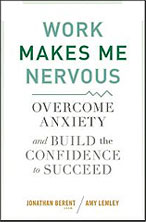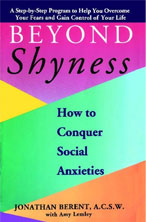Conversation Anxiety

View/Download Complete PDF of this Ebook
often an important process, involves different neural pathways. You need to practice to improve skills. There’s no way around this fact. To confront your conversation anxiety, you must set about retraining your mind and body so the anxiety response becomes a “ready, set, go” feeling you won’t want to avoid conversations.
Here’s an example of accessing and using different neural pathways. Many years ago when I was a counselor in a summer camp, I accidentally put my hand through a glass door, which required stitches in my right hand. Now, this is the hand I use to shoot a basketball and much of my summer experience at that time was on the basketball court. Trying to be positive about the situation, I started to practice foul shots with my left hand. This was very challenging. But, after a couple of weeks, I was fairly good at it. I must admit, I did not continue with left- hand shooting after my right hand healed; however, it was a very interesting learning experience.
About the BioCard
Throughout this e-book, I will refer to a device called the BioCard. Although it is not an essential part of using this e-book, it will greatly enhance your learning process. This card is available to you at my cost: $3 plus shipping and handling; it is a highly affordable and highly effective training aid. With the credit card-size device in hand, you are able to measure your hand temperature and associate it with your degree of stress or relaxation. Over time, you will learn (1) to identify the internal sensations of relaxation and (2) to differentiate between positive and negative stress. You can then link your conversation anxiety thinking with your physical response to anxiety triggers. The BioCard is simple to use, and because it is small, you can take it anywhere. When you choose to, you merely hold it between thumb and forefinger for 10
seconds, then check the color against the four-color key to determine your physical stress level (as indicated by the skin temperature of your hands). In developing this awareness, you can attach to the dynamic of hand temperature being cold or warm. This brings an unconscious adaptation into the consciousness by connecting thoughts and feelings to skin temperature. Rather than merely “getting through” an anxiety-provoking conversation, you are then able to concentrate on it. We offer a step-by-step process for achieving this awareness in Work Makes Me Nervous
Whether you use the BioCard or not, your goal is to attach and become productively aware of the connection between the mental and the physical responses you experience during conversation.
Anxiety Symptoms and Triggers
What anxiety symptoms do you experience before or during a conversation? What types of conversation make you nervous? The answers to this question vary from person to person. One person may have a racing pulse or obsessive thoughts; another might have cold clammy hands or a desire to “flee the scene.” Some may have all those reactions”or different ones altogether. The type of conversation that causes one person anxiety may be something that another conversation anxiety sufferer considers energizing and fun. Yet the fears and feelings are much the same from person to person: “I’m afraid I’ll say something stupid.” “I’m scared I’ll make a bad impression.” “They can see I don’t fit in.” “I’m sure they can tell I’m nervous.” “I have to say just the right thing.” This is what some of my clients have said about their conversation anxiety:
“Whenever I meet new people”at a party, at work, wherever”I start to blush”and I can’t concentrate on what we’re talking about. Not only do I forget their names right away, but once the conversation ends, I can hardly remember what we talked about. I am that distracted by my worry that they can see I’m uncomfortable.”
“Two friends of mine and I formed a book club last year. I love to read, and getting together over lunch to talk about favorite books was fun. But over the last year, my friends have invited six other women to join our group. That is not at all what I had in mind. I no longer say anything at all in our club, and I often skip our meetings to avoid being put on the spot. It makes me sad because I really liked our small group. But I just can’t stand when my voice quivers “I’d rather miss out than risk having everyone see how nervous I am.”
“Every three months, it’s my turn at work to share with my work team the latest ‘tips and tricks’ I’ve learned for web design. I always have tons of new things to talk about. But when those meetings come around, I am so afraid that my mind will go blank. Sometimes it does! Everyone must think I’m stupid because I can’t do this simple thing. I know I seem unprepared and they know I’m nervous. I sometimes call in sick on the day of my presentation, even though my annual performance review reflects that I fail to meet this job requirement.”
Here are the most commonly reported symptoms of conversation anxiety:
Mind going blank
Stammering
Stuttering
Obsessive thoughts (“I will look stupid,” “I don’t fit in,” “They can tell I’m nervous,” etc.)
Racing pulse
Cold, clammy hands
Sweating
Blushing
Nausea
Rapid breathing
What other symptoms do you experience?
As you read the list, check off the ones you have experienced. Then, write each symptom down in the grid that follows. If possible, recall and write down a specific example where you had these symptoms. Tip: Return to this list from time to time. Even if only a few examples come to mind right now, you will definitely recall others as you read this book. Write ‘em down! The more specific you can be about your conversation anxiety, the more quickly and successfully you can gain control of it.
| Symptoms | Specific Situation |
Ask and Answer”here is a conversation to have with yourself about the Symptom/Situation Exercise you just completed. Take your time. Really focus on each question. Be as honest as possible. Remember, this is a private conversation with yourself, so you have nothing to lose.
This exercise is critical. When was the last time you left your home to go somewhere familiar? Think about this for a moment: for shopping, work, school, the gym, for a date, to see a movie? When you left your point of origin, whether you were walking, driving, or taking public transportation, you knew what streets to walk or drive down. You knew where to make turns, what landmarks to pass, what numbers to look for. You had a map in your mind, information your brain had processed, something that you may have taken for granted. You knew where you were going. If you didn’t, you had to find the right information to reach your destination.
It’s crucial that you know where you are going”you need a map for the resolution of your conversation anxiety. But first you must determine where you are. That’s what this next exercise is about: Establishing a baseline that delineates your particular symptoms, what triggers
them, and how they affect your life. In each instance, you’ll see two examples Amy completed;
that’s just to get you started, and not to suggest that you yourself have the same symptoms. If you do, of course, then write them down.
1. What symptoms come up most often?
1. Obsessive worry that I will make a mistake, look stupid, seem noticeably nervous<
2. Uncomfortable, shallow breathing
2. When you feel those symptoms, what goes through your mind? What do you say to yourself?
1. “I’ve gotta get out of here before anyone sees what a nervous wreck I am.”
2. “Everyone can see I am nervous and uncomfortable.”
3. What are the situations that cause you the most anxiety?
1. Getting an e-mail from my boss asking if I’ve completed a task (especially if I have forgotten it.)
2.) Attending a party where I don’t know anyone but my date.
4. In the hours or days that follow an anxiety response to those situations, do you go back over them in your mind? What thoughts do you have?
“This is just one more piece of evidence for her; she thinks I’m incompetent.”
“I’d better stick by my date and not say anything. Otherwise I’ll make a bad impression.”
5. Do you avoid some of the specific situations you have identified as triggers? Describe some of the times you have done so. What did you feel in the moment you decided to avoid them? Be as specific as possible and, if you can, zero in on one particular example.
1. Yes. I was terrified of my performance review meeting; even though I was meeting my written goals, I was afraid my boss would spring something on me and I wouldn’t have an answer. I had to go to the meeting, but afterward, I chose not to read my written review. In that moment, I told myself I simply didn’t need to. Deep down, I judge myself for being “crazy enough” to avoid something everyone else would not think is a big deal. I feel worthless.
2. Sometimes, I make an excuse to avoid going on a date to a party. I feel bad about it because I don’t want to seem like I am rejecting him.”
In this last example, Amy chose to “attach” to the negative feelings of conversation anxiety and its aftermath rather than the objective knowledge that her assessment had gone fine and she was “meeting expectations.” (Do you attach to your conversation something you do?
Do You Hide Behind Technology or the Written Word?
These days, people communicate all day long without ever speaking a word aloud. It’s as though they are tweeting with their toes, texting with their thumbs, typing out e-mails with their teeth, and IM-ing with their elbows while they tune out the world and listen to their own personal
soundtrack through ear buds attached to an iPod.


